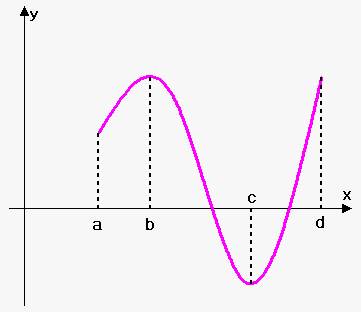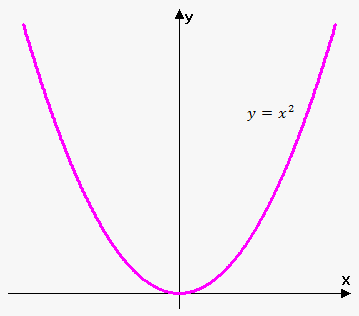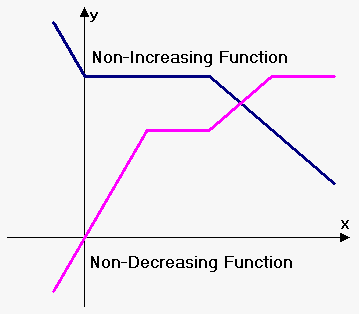Increasing and Decreasing Functions
 A function $$${f{}}$$$ is called increasing on interval $$${I}$$$ if $$${f{{\left({x}_{{1}}\right)}}}<{f{{\left({x}_{{2}}\right)}}}$$$ whenever $$${x}_{{1}}<{x}_{{2}}$$$ in $$${I}$$$.
A function $$${f{}}$$$ is called increasing on interval $$${I}$$$ if $$${f{{\left({x}_{{1}}\right)}}}<{f{{\left({x}_{{2}}\right)}}}$$$ whenever $$${x}_{{1}}<{x}_{{2}}$$$ in $$${I}$$$.
A function $$${f{}}$$$ is called decreasing on interval $$${I}$$$ if $$${f{{\left({x}_{{1}}\right)}}}>{f{{\left({x}_{{2}}\right)}}}$$$ whenever $$${x}_{{1}}>{x}_{{2}}$$$ in $$${I}$$$.
A function $$${f{}}$$$ is called non-decreasing on interval $$${I}$$$ if $$${f{{\left({x}_{{1}}\right)}}}\le{f{{\left({x}_{{2}}\right)}}}$$$ whenever $$${x}_{{1}}<{x}_{{2}}$$$ in $$${I}$$$.
A function $$${f{}}$$$ is called non-icreasing on interval $$${I}$$$ if $$${f{{\left({x}_{{1}}\right)}}}>{f{{\left({x}_{{2}}\right)}}}$$$ whenever $$${x}_{{1}}>{x}_{{2}}$$$ in $$${I}$$$.
All above types of functions have common name. They are called monotonic.

It is important to understand that in definition of increasing $$${f{{\left({x}_{{1}}\right)}}}<{f{{\left({x}_{{2}}\right)}}}$$$ should hold for any $$${x}_{{1}}$$$ and $$${x}_{{2}}$$$ such that $$${x}_{{1}}<{x}_{{2}}$$$. Same can be said about definition of decreasing, non-decreasing and non-increasing functions.
Consider function on the figure. It is increasing on interval $$${\left[{a},{b}\right]}$$$ and $$${\left[{c},{d}\right]}$$$, and decreasing on interval $$${\left[{b},{c}\right]}$$$.
Function $$${f{{\left({x}\right)}}}={{x}}^{{2}}$$$ is increasing on interval $$${\left[{0},\infty\right)}$$$ and decreasing on interval $$${\left(-\infty,{0}\right)}$$$.
 The only difference between increasing and non-decreasing, decreasing and non-increasing is that function can take constant value on some subinterval(s) of $$$I$$$. See the figure to the right.
The only difference between increasing and non-decreasing, decreasing and non-increasing is that function can take constant value on some subinterval(s) of $$$I$$$. See the figure to the right.
